College of Business: Moore's Law and IT Industry Evolution
VerifiedAdded on 2022/08/14
|6
|2090
|26
Report
AI Summary
This report delves into Moore's Law, the observation that the number of transistors on integrated circuits doubles approximately every two years, as proposed by Gordon Moore. It examines the law's significant impact on the IT industry, particularly on IT manufacturers, highlighting how it has driven exponential growth in computing power and complexity while reducing costs. The report discusses the various interpretations of Moore's Law, including its influence on microprocessor power, computing power, and the price of computing. It explores the technical implications, challenges related to exponential growth, and the broader influence of Moore's Law on society and technological advancements. The analysis also touches upon the potential limitations and dilemmas of Moore's Law, emphasizing the need for innovation and adaptation in the face of rapid technological changes, and the importance of understanding how exponential technological progress affects human lives and the future of technology. The report concludes by emphasizing Moore's Law's critical role in shaping the digital age and its implications for both technological and societal evolution.
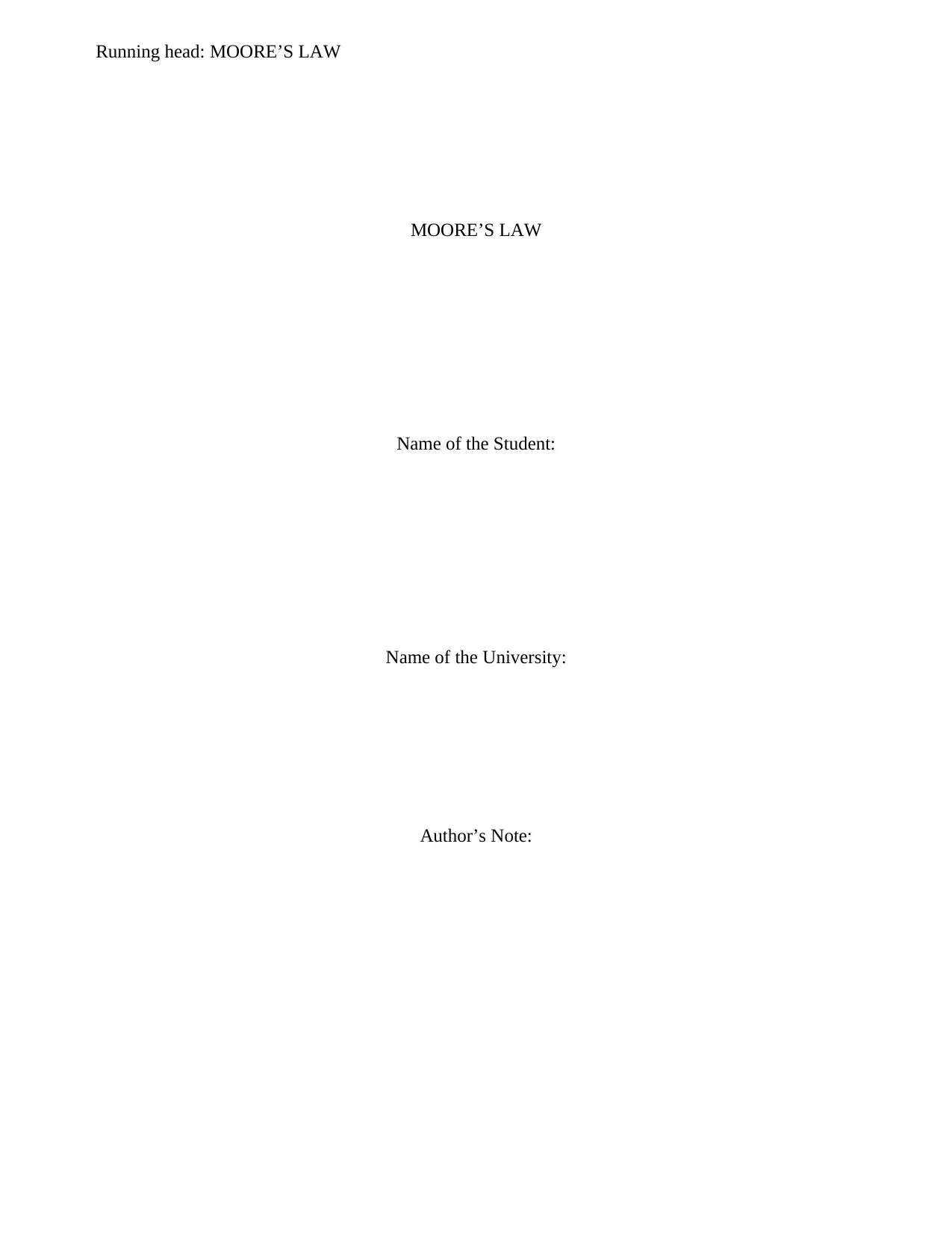
Running head: MOORE’S LAW
MOORE’S LAW
Name of the Student:
Name of the University:
Author’s Note:
MOORE’S LAW
Name of the Student:
Name of the University:
Author’s Note:
Paraphrase This Document
Need a fresh take? Get an instant paraphrase of this document with our AI Paraphraser
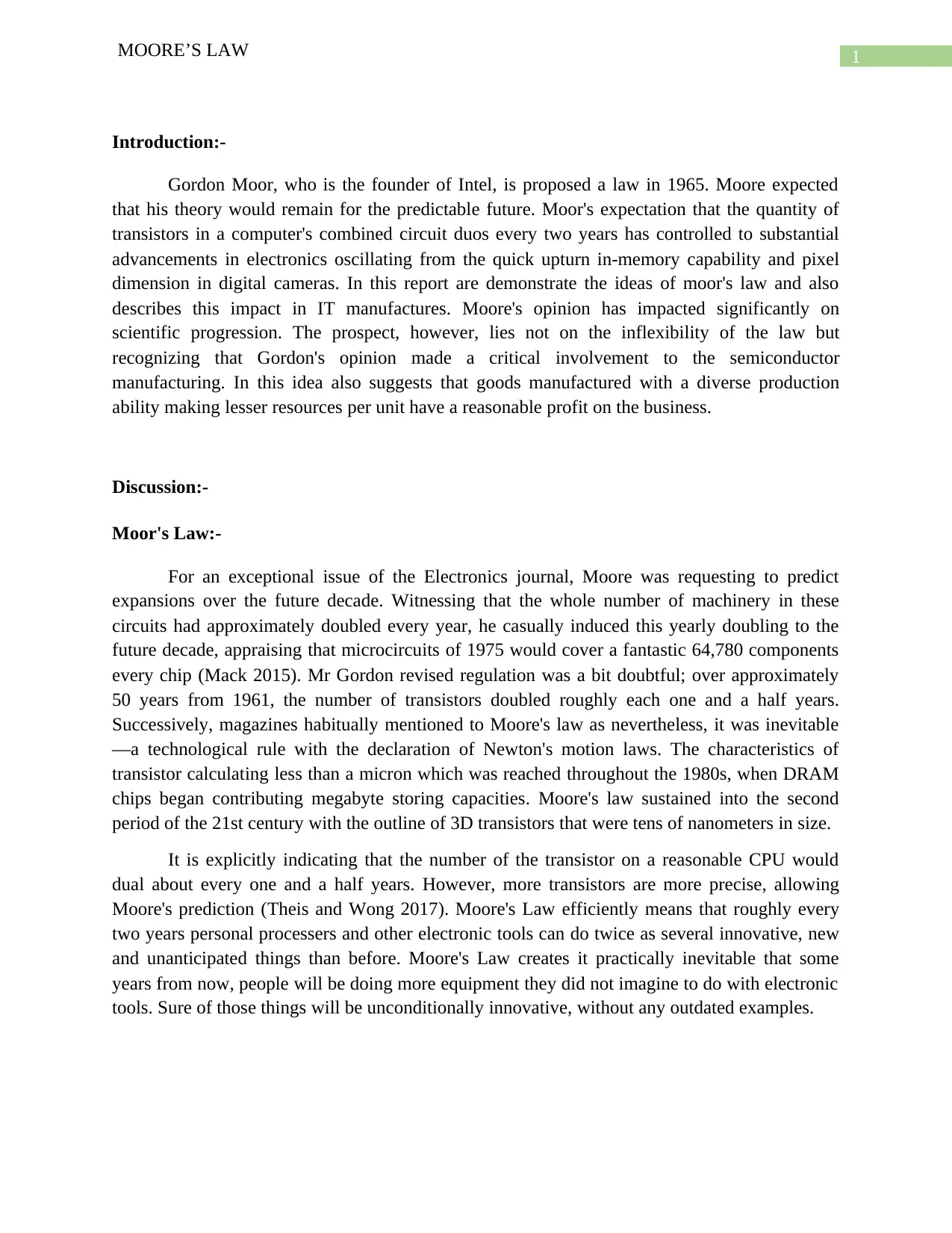
1MOORE’S LAW
Introduction:-
Gordon Moor, who is the founder of Intel, is proposed a law in 1965. Moore expected
that his theory would remain for the predictable future. Moor's expectation that the quantity of
transistors in a computer's combined circuit duos every two years has controlled to substantial
advancements in electronics oscillating from the quick upturn in-memory capability and pixel
dimension in digital cameras. In this report are demonstrate the ideas of moor's law and also
describes this impact in IT manufactures. Moore's opinion has impacted significantly on
scientific progression. The prospect, however, lies not on the inflexibility of the law but
recognizing that Gordon's opinion made a critical involvement to the semiconductor
manufacturing. In this idea also suggests that goods manufactured with a diverse production
ability making lesser resources per unit have a reasonable profit on the business.
Discussion:-
Moor's Law:-
For an exceptional issue of the Electronics journal, Moore was requesting to predict
expansions over the future decade. Witnessing that the whole number of machinery in these
circuits had approximately doubled every year, he casually induced this yearly doubling to the
future decade, appraising that microcircuits of 1975 would cover a fantastic 64,780 components
every chip (Mack 2015). Mr Gordon revised regulation was a bit doubtful; over approximately
50 years from 1961, the number of transistors doubled roughly each one and a half years.
Successively, magazines habitually mentioned to Moore's law as nevertheless, it was inevitable
—a technological rule with the declaration of Newton's motion laws. The characteristics of
transistor calculating less than a micron which was reached throughout the 1980s, when DRAM
chips began contributing megabyte storing capacities. Moore's law sustained into the second
period of the 21st century with the outline of 3D transistors that were tens of nanometers in size.
It is explicitly indicating that the number of the transistor on a reasonable CPU would
dual about every one and a half years. However, more transistors are more precise, allowing
Moore's prediction (Theis and Wong 2017). Moore's Law efficiently means that roughly every
two years personal processers and other electronic tools can do twice as several innovative, new
and unanticipated things than before. Moore's Law creates it practically inevitable that some
years from now, people will be doing more equipment they did not imagine to do with electronic
tools. Sure of those things will be unconditionally innovative, without any outdated examples.
Introduction:-
Gordon Moor, who is the founder of Intel, is proposed a law in 1965. Moore expected
that his theory would remain for the predictable future. Moor's expectation that the quantity of
transistors in a computer's combined circuit duos every two years has controlled to substantial
advancements in electronics oscillating from the quick upturn in-memory capability and pixel
dimension in digital cameras. In this report are demonstrate the ideas of moor's law and also
describes this impact in IT manufactures. Moore's opinion has impacted significantly on
scientific progression. The prospect, however, lies not on the inflexibility of the law but
recognizing that Gordon's opinion made a critical involvement to the semiconductor
manufacturing. In this idea also suggests that goods manufactured with a diverse production
ability making lesser resources per unit have a reasonable profit on the business.
Discussion:-
Moor's Law:-
For an exceptional issue of the Electronics journal, Moore was requesting to predict
expansions over the future decade. Witnessing that the whole number of machinery in these
circuits had approximately doubled every year, he casually induced this yearly doubling to the
future decade, appraising that microcircuits of 1975 would cover a fantastic 64,780 components
every chip (Mack 2015). Mr Gordon revised regulation was a bit doubtful; over approximately
50 years from 1961, the number of transistors doubled roughly each one and a half years.
Successively, magazines habitually mentioned to Moore's law as nevertheless, it was inevitable
—a technological rule with the declaration of Newton's motion laws. The characteristics of
transistor calculating less than a micron which was reached throughout the 1980s, when DRAM
chips began contributing megabyte storing capacities. Moore's law sustained into the second
period of the 21st century with the outline of 3D transistors that were tens of nanometers in size.
It is explicitly indicating that the number of the transistor on a reasonable CPU would
dual about every one and a half years. However, more transistors are more precise, allowing
Moore's prediction (Theis and Wong 2017). Moore's Law efficiently means that roughly every
two years personal processers and other electronic tools can do twice as several innovative, new
and unanticipated things than before. Moore's Law creates it practically inevitable that some
years from now, people will be doing more equipment they did not imagine to do with electronic
tools. Sure of those things will be unconditionally innovative, without any outdated examples.
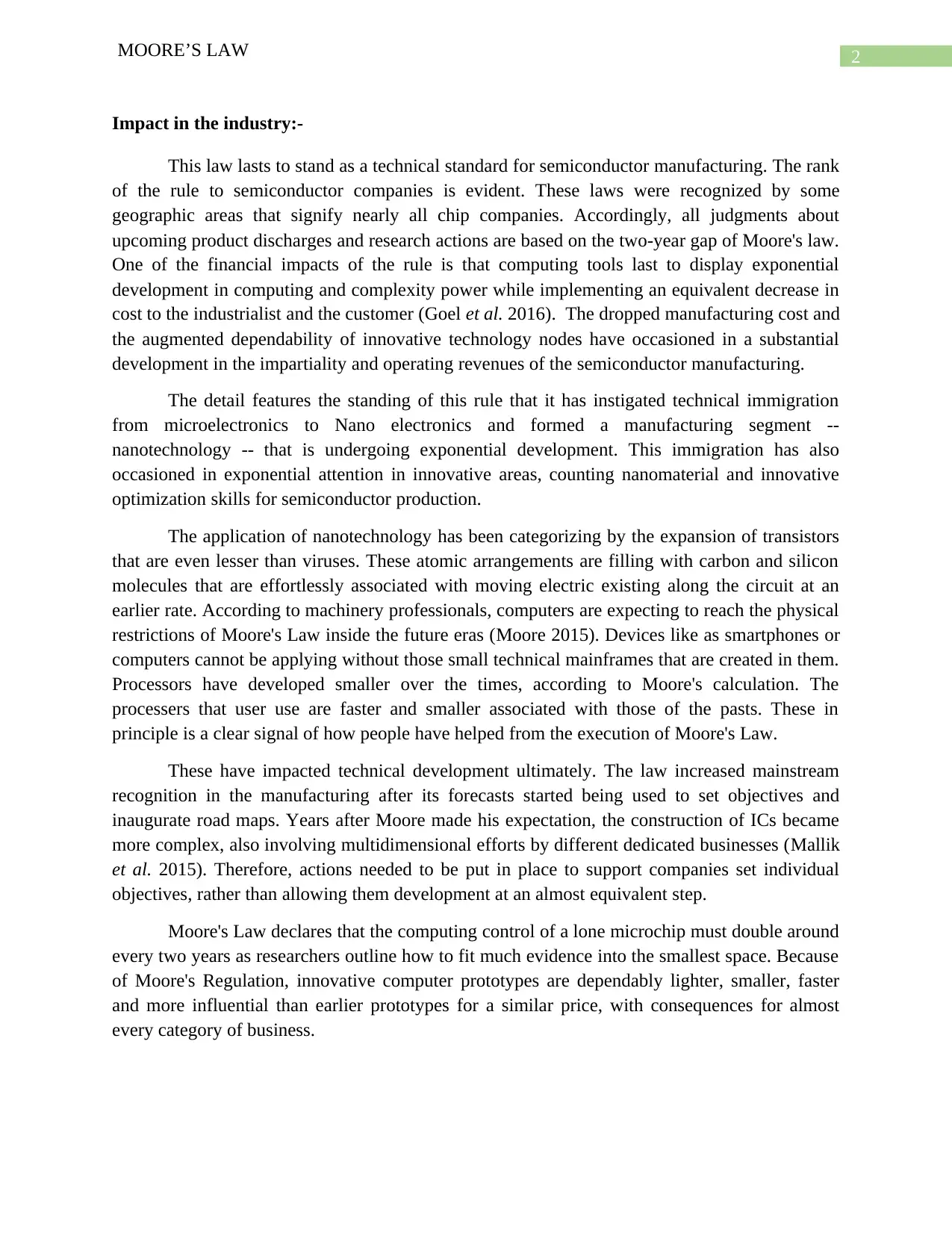
2MOORE’S LAW
Impact in the industry:-
This law lasts to stand as a technical standard for semiconductor manufacturing. The rank
of the rule to semiconductor companies is evident. These laws were recognized by some
geographic areas that signify nearly all chip companies. Accordingly, all judgments about
upcoming product discharges and research actions are based on the two-year gap of Moore's law.
One of the financial impacts of the rule is that computing tools last to display exponential
development in computing and complexity power while implementing an equivalent decrease in
cost to the industrialist and the customer (Goel et al. 2016). The dropped manufacturing cost and
the augmented dependability of innovative technology nodes have occasioned in a substantial
development in the impartiality and operating revenues of the semiconductor manufacturing.
The detail features the standing of this rule that it has instigated technical immigration
from microelectronics to Nano electronics and formed a manufacturing segment --
nanotechnology -- that is undergoing exponential development. This immigration has also
occasioned in exponential attention in innovative areas, counting nanomaterial and innovative
optimization skills for semiconductor production.
The application of nanotechnology has been categorizing by the expansion of transistors
that are even lesser than viruses. These atomic arrangements are filling with carbon and silicon
molecules that are effortlessly associated with moving electric existing along the circuit at an
earlier rate. According to machinery professionals, computers are expecting to reach the physical
restrictions of Moore's Law inside the future eras (Moore 2015). Devices like as smartphones or
computers cannot be applying without those small technical mainframes that are created in them.
Processors have developed smaller over the times, according to Moore's calculation. The
processers that user use are faster and smaller associated with those of the pasts. These in
principle is a clear signal of how people have helped from the execution of Moore's Law.
These have impacted technical development ultimately. The law increased mainstream
recognition in the manufacturing after its forecasts started being used to set objectives and
inaugurate road maps. Years after Moore made his expectation, the construction of ICs became
more complex, also involving multidimensional efforts by different dedicated businesses (Mallik
et al. 2015). Therefore, actions needed to be put in place to support companies set individual
objectives, rather than allowing them development at an almost equivalent step.
Moore's Law declares that the computing control of a lone microchip must double around
every two years as researchers outline how to fit much evidence into the smallest space. Because
of Moore's Regulation, innovative computer prototypes are dependably lighter, smaller, faster
and more influential than earlier prototypes for a similar price, with consequences for almost
every category of business.
Impact in the industry:-
This law lasts to stand as a technical standard for semiconductor manufacturing. The rank
of the rule to semiconductor companies is evident. These laws were recognized by some
geographic areas that signify nearly all chip companies. Accordingly, all judgments about
upcoming product discharges and research actions are based on the two-year gap of Moore's law.
One of the financial impacts of the rule is that computing tools last to display exponential
development in computing and complexity power while implementing an equivalent decrease in
cost to the industrialist and the customer (Goel et al. 2016). The dropped manufacturing cost and
the augmented dependability of innovative technology nodes have occasioned in a substantial
development in the impartiality and operating revenues of the semiconductor manufacturing.
The detail features the standing of this rule that it has instigated technical immigration
from microelectronics to Nano electronics and formed a manufacturing segment --
nanotechnology -- that is undergoing exponential development. This immigration has also
occasioned in exponential attention in innovative areas, counting nanomaterial and innovative
optimization skills for semiconductor production.
The application of nanotechnology has been categorizing by the expansion of transistors
that are even lesser than viruses. These atomic arrangements are filling with carbon and silicon
molecules that are effortlessly associated with moving electric existing along the circuit at an
earlier rate. According to machinery professionals, computers are expecting to reach the physical
restrictions of Moore's Law inside the future eras (Moore 2015). Devices like as smartphones or
computers cannot be applying without those small technical mainframes that are created in them.
Processors have developed smaller over the times, according to Moore's calculation. The
processers that user use are faster and smaller associated with those of the pasts. These in
principle is a clear signal of how people have helped from the execution of Moore's Law.
These have impacted technical development ultimately. The law increased mainstream
recognition in the manufacturing after its forecasts started being used to set objectives and
inaugurate road maps. Years after Moore made his expectation, the construction of ICs became
more complex, also involving multidimensional efforts by different dedicated businesses (Mallik
et al. 2015). Therefore, actions needed to be put in place to support companies set individual
objectives, rather than allowing them development at an almost equivalent step.
Moore's Law declares that the computing control of a lone microchip must double around
every two years as researchers outline how to fit much evidence into the smallest space. Because
of Moore's Regulation, innovative computer prototypes are dependably lighter, smaller, faster
and more influential than earlier prototypes for a similar price, with consequences for almost
every category of business.
⊘ This is a preview!⊘
Do you want full access?
Subscribe today to unlock all pages.

Trusted by 1+ million students worldwide
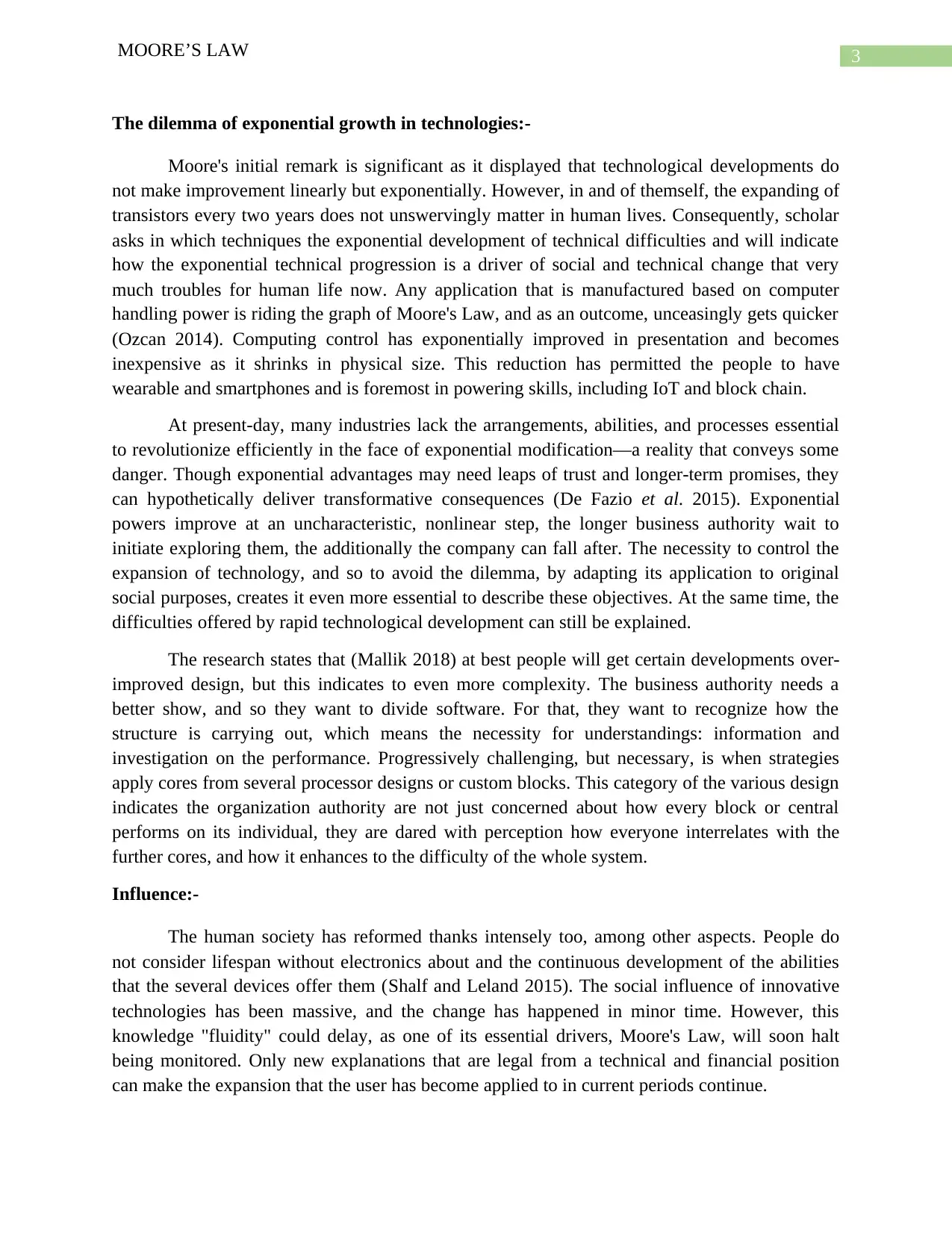
3MOORE’S LAW
The dilemma of exponential growth in technologies:-
Moore's initial remark is significant as it displayed that technological developments do
not make improvement linearly but exponentially. However, in and of themself, the expanding of
transistors every two years does not unswervingly matter in human lives. Consequently, scholar
asks in which techniques the exponential development of technical difficulties and will indicate
how the exponential technical progression is a driver of social and technical change that very
much troubles for human life now. Any application that is manufactured based on computer
handling power is riding the graph of Moore's Law, and as an outcome, unceasingly gets quicker
(Ozcan 2014). Computing control has exponentially improved in presentation and becomes
inexpensive as it shrinks in physical size. This reduction has permitted the people to have
wearable and smartphones and is foremost in powering skills, including IoT and block chain.
At present-day, many industries lack the arrangements, abilities, and processes essential
to revolutionize efficiently in the face of exponential modification—a reality that conveys some
danger. Though exponential advantages may need leaps of trust and longer-term promises, they
can hypothetically deliver transformative consequences (De Fazio et al. 2015). Exponential
powers improve at an uncharacteristic, nonlinear step, the longer business authority wait to
initiate exploring them, the additionally the company can fall after. The necessity to control the
expansion of technology, and so to avoid the dilemma, by adapting its application to original
social purposes, creates it even more essential to describe these objectives. At the same time, the
difficulties offered by rapid technological development can still be explained.
The research states that (Mallik 2018) at best people will get certain developments over-
improved design, but this indicates to even more complexity. The business authority needs a
better show, and so they want to divide software. For that, they want to recognize how the
structure is carrying out, which means the necessity for understandings: information and
investigation on the performance. Progressively challenging, but necessary, is when strategies
apply cores from several processor designs or custom blocks. This category of the various design
indicates the organization authority are not just concerned about how every block or central
performs on its individual, they are dared with perception how everyone interrelates with the
further cores, and how it enhances to the difficulty of the whole system.
Influence:-
The human society has reformed thanks intensely too, among other aspects. People do
not consider lifespan without electronics about and the continuous development of the abilities
that the several devices offer them (Shalf and Leland 2015). The social influence of innovative
technologies has been massive, and the change has happened in minor time. However, this
knowledge "fluidity" could delay, as one of its essential drivers, Moore's Law, will soon halt
being monitored. Only new explanations that are legal from a technical and financial position
can make the expansion that the user has become applied to in current periods continue.
The dilemma of exponential growth in technologies:-
Moore's initial remark is significant as it displayed that technological developments do
not make improvement linearly but exponentially. However, in and of themself, the expanding of
transistors every two years does not unswervingly matter in human lives. Consequently, scholar
asks in which techniques the exponential development of technical difficulties and will indicate
how the exponential technical progression is a driver of social and technical change that very
much troubles for human life now. Any application that is manufactured based on computer
handling power is riding the graph of Moore's Law, and as an outcome, unceasingly gets quicker
(Ozcan 2014). Computing control has exponentially improved in presentation and becomes
inexpensive as it shrinks in physical size. This reduction has permitted the people to have
wearable and smartphones and is foremost in powering skills, including IoT and block chain.
At present-day, many industries lack the arrangements, abilities, and processes essential
to revolutionize efficiently in the face of exponential modification—a reality that conveys some
danger. Though exponential advantages may need leaps of trust and longer-term promises, they
can hypothetically deliver transformative consequences (De Fazio et al. 2015). Exponential
powers improve at an uncharacteristic, nonlinear step, the longer business authority wait to
initiate exploring them, the additionally the company can fall after. The necessity to control the
expansion of technology, and so to avoid the dilemma, by adapting its application to original
social purposes, creates it even more essential to describe these objectives. At the same time, the
difficulties offered by rapid technological development can still be explained.
The research states that (Mallik 2018) at best people will get certain developments over-
improved design, but this indicates to even more complexity. The business authority needs a
better show, and so they want to divide software. For that, they want to recognize how the
structure is carrying out, which means the necessity for understandings: information and
investigation on the performance. Progressively challenging, but necessary, is when strategies
apply cores from several processor designs or custom blocks. This category of the various design
indicates the organization authority are not just concerned about how every block or central
performs on its individual, they are dared with perception how everyone interrelates with the
further cores, and how it enhances to the difficulty of the whole system.
Influence:-
The human society has reformed thanks intensely too, among other aspects. People do
not consider lifespan without electronics about and the continuous development of the abilities
that the several devices offer them (Shalf and Leland 2015). The social influence of innovative
technologies has been massive, and the change has happened in minor time. However, this
knowledge "fluidity" could delay, as one of its essential drivers, Moore's Law, will soon halt
being monitored. Only new explanations that are legal from a technical and financial position
can make the expansion that the user has become applied to in current periods continue.
Paraphrase This Document
Need a fresh take? Get an instant paraphrase of this document with our AI Paraphraser
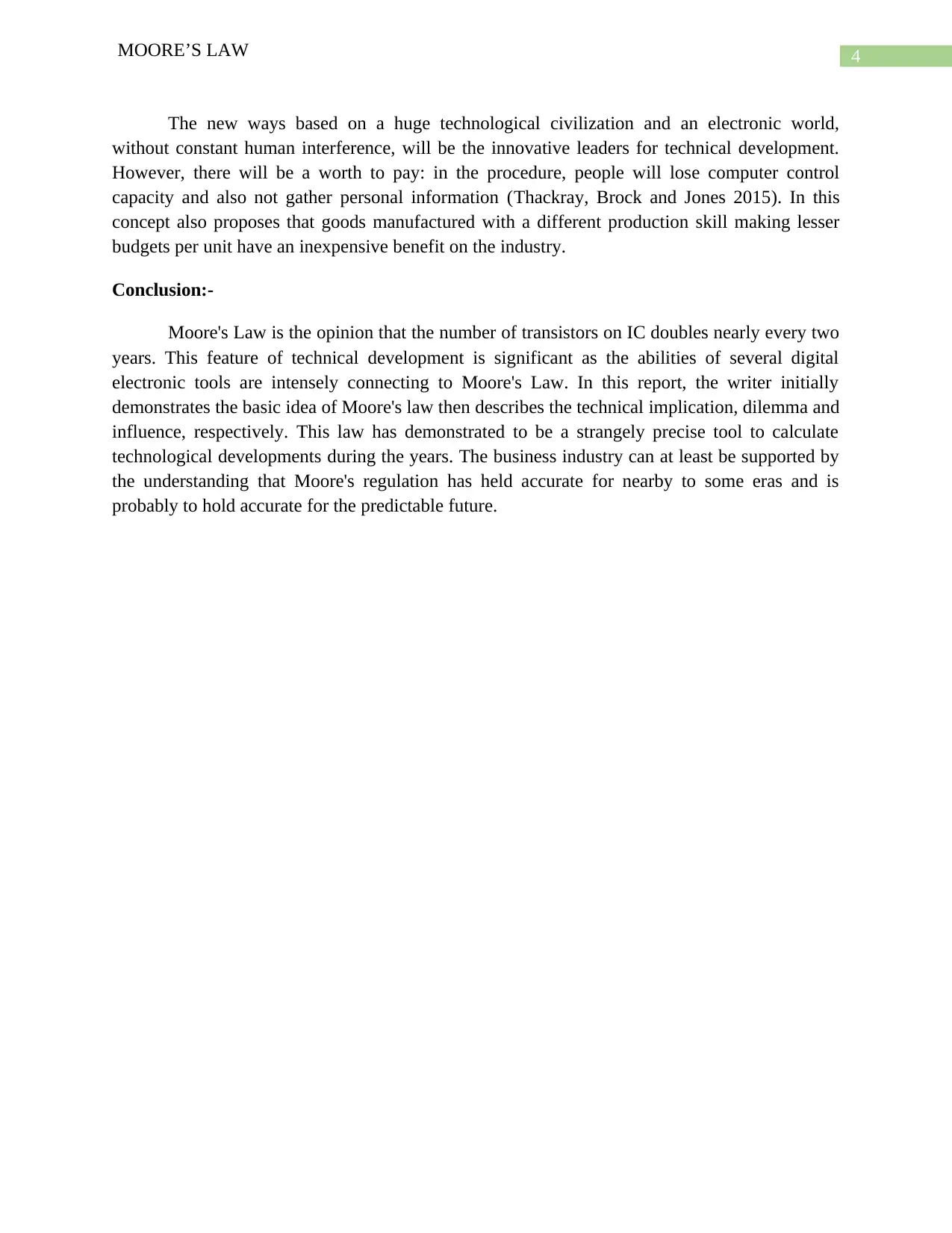
4MOORE’S LAW
The new ways based on a huge technological civilization and an electronic world,
without constant human interference, will be the innovative leaders for technical development.
However, there will be a worth to pay: in the procedure, people will lose computer control
capacity and also not gather personal information (Thackray, Brock and Jones 2015). In this
concept also proposes that goods manufactured with a different production skill making lesser
budgets per unit have an inexpensive benefit on the industry.
Conclusion:-
Moore's Law is the opinion that the number of transistors on IC doubles nearly every two
years. This feature of technical development is significant as the abilities of several digital
electronic tools are intensely connecting to Moore's Law. In this report, the writer initially
demonstrates the basic idea of Moore's law then describes the technical implication, dilemma and
influence, respectively. This law has demonstrated to be a strangely precise tool to calculate
technological developments during the years. The business industry can at least be supported by
the understanding that Moore's regulation has held accurate for nearby to some eras and is
probably to hold accurate for the predictable future.
The new ways based on a huge technological civilization and an electronic world,
without constant human interference, will be the innovative leaders for technical development.
However, there will be a worth to pay: in the procedure, people will lose computer control
capacity and also not gather personal information (Thackray, Brock and Jones 2015). In this
concept also proposes that goods manufactured with a different production skill making lesser
budgets per unit have an inexpensive benefit on the industry.
Conclusion:-
Moore's Law is the opinion that the number of transistors on IC doubles nearly every two
years. This feature of technical development is significant as the abilities of several digital
electronic tools are intensely connecting to Moore's Law. In this report, the writer initially
demonstrates the basic idea of Moore's law then describes the technical implication, dilemma and
influence, respectively. This law has demonstrated to be a strangely precise tool to calculate
technological developments during the years. The business industry can at least be supported by
the understanding that Moore's regulation has held accurate for nearby to some eras and is
probably to hold accurate for the predictable future.
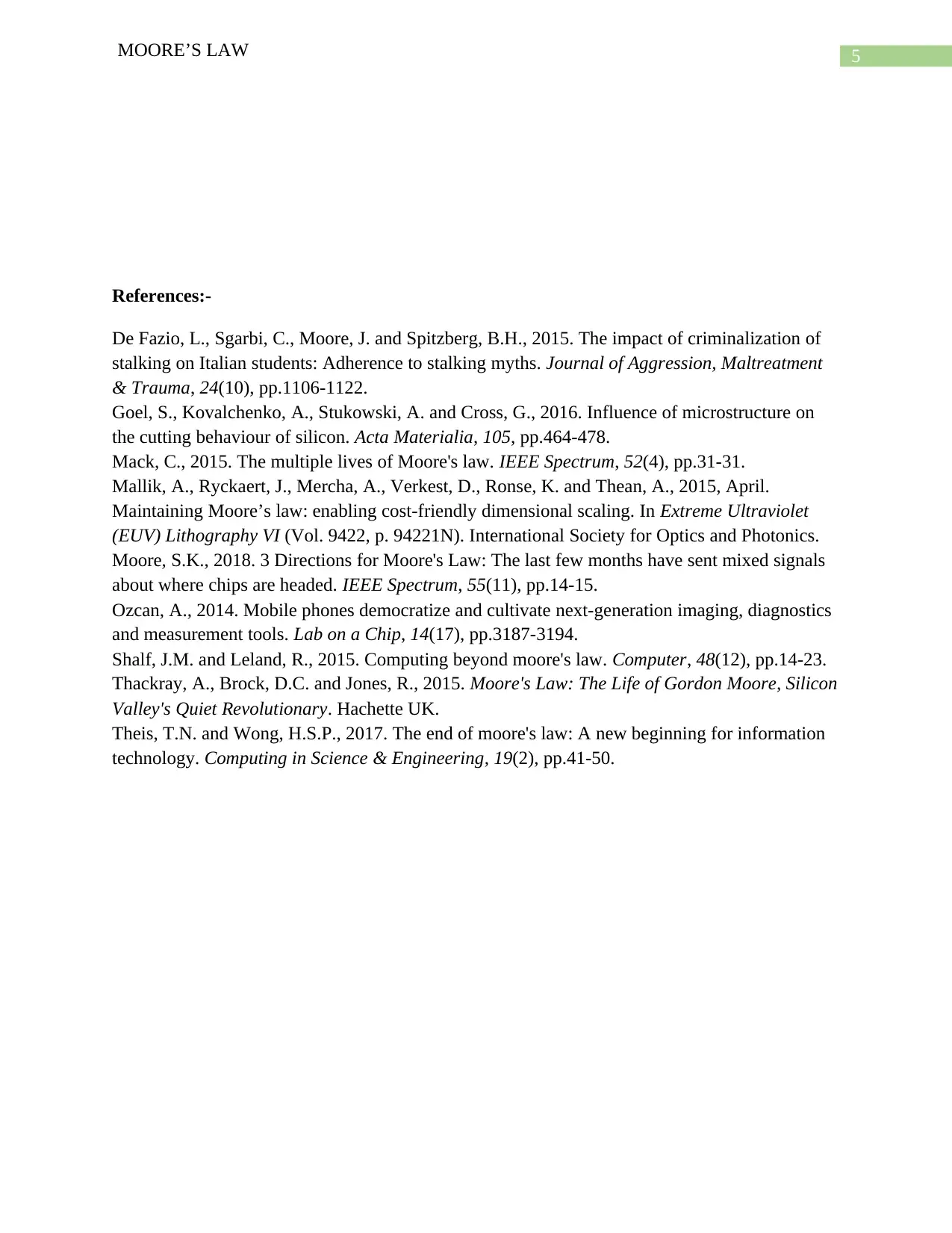
5MOORE’S LAW
References:-
De Fazio, L., Sgarbi, C., Moore, J. and Spitzberg, B.H., 2015. The impact of criminalization of
stalking on Italian students: Adherence to stalking myths. Journal of Aggression, Maltreatment
& Trauma, 24(10), pp.1106-1122.
Goel, S., Kovalchenko, A., Stukowski, A. and Cross, G., 2016. Influence of microstructure on
the cutting behaviour of silicon. Acta Materialia, 105, pp.464-478.
Mack, C., 2015. The multiple lives of Moore's law. IEEE Spectrum, 52(4), pp.31-31.
Mallik, A., Ryckaert, J., Mercha, A., Verkest, D., Ronse, K. and Thean, A., 2015, April.
Maintaining Moore’s law: enabling cost-friendly dimensional scaling. In Extreme Ultraviolet
(EUV) Lithography VI (Vol. 9422, p. 94221N). International Society for Optics and Photonics.
Moore, S.K., 2018. 3 Directions for Moore's Law: The last few months have sent mixed signals
about where chips are headed. IEEE Spectrum, 55(11), pp.14-15.
Ozcan, A., 2014. Mobile phones democratize and cultivate next-generation imaging, diagnostics
and measurement tools. Lab on a Chip, 14(17), pp.3187-3194.
Shalf, J.M. and Leland, R., 2015. Computing beyond moore's law. Computer, 48(12), pp.14-23.
Thackray, A., Brock, D.C. and Jones, R., 2015. Moore's Law: The Life of Gordon Moore, Silicon
Valley's Quiet Revolutionary. Hachette UK.
Theis, T.N. and Wong, H.S.P., 2017. The end of moore's law: A new beginning for information
technology. Computing in Science & Engineering, 19(2), pp.41-50.
References:-
De Fazio, L., Sgarbi, C., Moore, J. and Spitzberg, B.H., 2015. The impact of criminalization of
stalking on Italian students: Adherence to stalking myths. Journal of Aggression, Maltreatment
& Trauma, 24(10), pp.1106-1122.
Goel, S., Kovalchenko, A., Stukowski, A. and Cross, G., 2016. Influence of microstructure on
the cutting behaviour of silicon. Acta Materialia, 105, pp.464-478.
Mack, C., 2015. The multiple lives of Moore's law. IEEE Spectrum, 52(4), pp.31-31.
Mallik, A., Ryckaert, J., Mercha, A., Verkest, D., Ronse, K. and Thean, A., 2015, April.
Maintaining Moore’s law: enabling cost-friendly dimensional scaling. In Extreme Ultraviolet
(EUV) Lithography VI (Vol. 9422, p. 94221N). International Society for Optics and Photonics.
Moore, S.K., 2018. 3 Directions for Moore's Law: The last few months have sent mixed signals
about where chips are headed. IEEE Spectrum, 55(11), pp.14-15.
Ozcan, A., 2014. Mobile phones democratize and cultivate next-generation imaging, diagnostics
and measurement tools. Lab on a Chip, 14(17), pp.3187-3194.
Shalf, J.M. and Leland, R., 2015. Computing beyond moore's law. Computer, 48(12), pp.14-23.
Thackray, A., Brock, D.C. and Jones, R., 2015. Moore's Law: The Life of Gordon Moore, Silicon
Valley's Quiet Revolutionary. Hachette UK.
Theis, T.N. and Wong, H.S.P., 2017. The end of moore's law: A new beginning for information
technology. Computing in Science & Engineering, 19(2), pp.41-50.
⊘ This is a preview!⊘
Do you want full access?
Subscribe today to unlock all pages.

Trusted by 1+ million students worldwide
1 out of 6
Your All-in-One AI-Powered Toolkit for Academic Success.
+13062052269
info@desklib.com
Available 24*7 on WhatsApp / Email
![[object Object]](/_next/static/media/star-bottom.7253800d.svg)
Unlock your academic potential
Copyright © 2020–2025 A2Z Services. All Rights Reserved. Developed and managed by ZUCOL.


